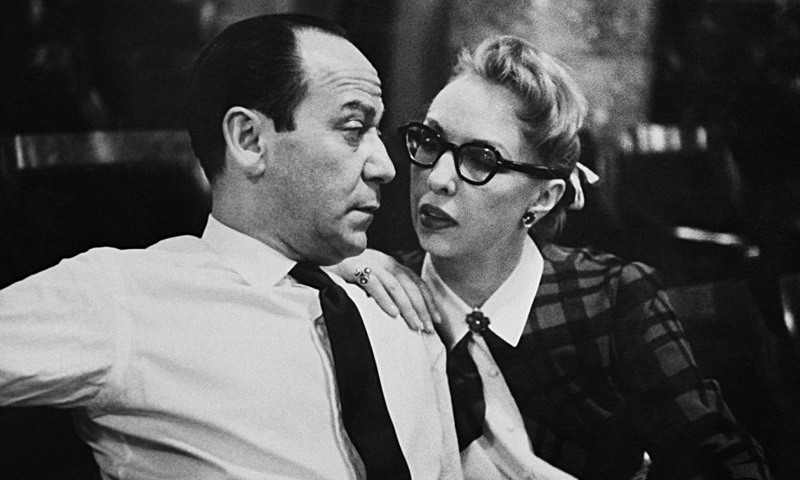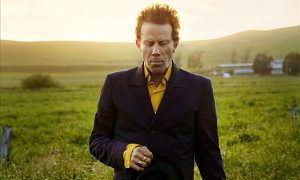Home » Jazz Articles » Anatomy of a Standard » "Baby, It's Cold Outside" by Frank Loesser
"Baby, It's Cold Outside" by Frank Loesser

The song was penned in 1944 and was premiered by Frank Loesser and his wife, Lynn Garland, at a housewarming party in New York. It was later included in the 1949 film, Neptune's Daughter, and subsequently won the Academy Award for Best Original Song. It has since been recorded by too many artists to mention, and remains one of the most recognizable duets ever written. Many parodies of the song have been performed including role-reversals and even depictions of a person trying to get their companion to leave rather than stay. However interpreted, "Baby, It's Cold Outside" takes its rightful place as an enduring standard in the Great American Songbook.
Form and Phrase Structure
The ABAC form (C being a blending of B with A) is structured as a call and response song in which the antecedent phrase is always answered by a consequent phrase in the form of a conversation between two people. The call and response effect is most profound given that the song is scored as a duet for "Mouse" and "Wolf." This scoring style is highly illustrative in presenting two contrasting points of view which only occasionally agree (when both sing the song title together). The female singer (most often singing the role of "Mouse") presents a phrase contour that ascends without resolution in the A sections (as though indecisive, vague, or at least leaving room for an opposing argument). The "Wolf's" (usually the male singer's) response ends in a downward, decisive, cadential manner. These phrases comically and quickly move through the conversation, designed as only one measure sub-phrases per character (in A). The sub-phrases even overlap slightly as the song continues, as if suggesting that the Wolf consistently interrupts the Mouse before she finishes her thoughts: at B, the sub-phrases extend to two measures each, with overlap forcing the consequent phrase (sung by "Wolf") to begin before the antecedent phrase (sung by "Mouse") is complete.
Lyrics and Melody
Here is a song whose music and lyrics work so well together that one might believe they actually are wed. Loesser went to great lengths to mimic an actual conversation that might be overheard between a strongly persuasive lover ("Wolf") urging his date ("Mouse") to stay under the pretense of stormy weather, amid her incessant excuses and polite protestations. The lyrics beautifully reflect the music when considering the scoring of her/his phrases: when she states that she "must go," her voice ascends a perfect fifth, strongly suggesting that her commitment to that action is literally up in the air. When the male voice comes back with his response, it is always in a descending contour, and often back to the tonic pitch, as if he is firm in his commitment to persuading her to stay. While she thinks of myriad reasons to go, and people who will be offended if she stays, he blithely offers her compliments on her hair and ramps up efforts toward hospitality (taking her hat, pouring her wine), rather than offering any comments whatsoever regarding the conflict she is experiencing. This winds up being a humorous study in male/female relationships that is so familiar that it strikes a palpable chord for those listening. It also makes for a potentially entertaining live performance!
At the bridge (B), the male character changes his tactics by parroting the female character's music in his consequent phrases (as if he now is hearing her point of view), but his actual lyrics are even more suggestive, sensual and seductive toward his own ends. Her ascending sixth suggests that her voice is growing louder in attempts to be engaged in the conversation she wishes to have, while his voice mockingly becomes softer to enhance the processes of seduction and distraction, now well under way. He finally makes progress by the end of the verse when he gets her to acknowledge, "Ah, but it's cold outside..." One of the beautiful things about this song (and so many Great American Songbook standards) is that the outcome of this conversation is left to the imagination of the listener. Did she ultimately go home, or was she persuaded to stay? Loesser does not answer that for us, but allows us to finish the story ourselves.
Harmony
Loesser exhibits terrific understanding of the balance between simplicity and complexity by choosing a very simplistic harmonic progression to accompany the intricately complex, sophisticated lyric and phrase structure here. The Wolf has sixty-four bars to begin, conduct, and conclude his dastardly agenda, so paring the harmony down to a bare-bones, functional approach ensures that harmonic complexity will not compete with the lyrics for the audience's attention. With "Wolf's" plan of persuasion unfolding gradually (coupled with "Mouse's" faltering, but opposing objective taking up half the lyrics), there was no time to muddy the piece with a distractingly complicated harmonic structure. Also, the melody already mirrors the decisiveness of each character, so the harmony's role appropriately serves the melody as stably and unobtrusively as possible.
The piece begins with stock I—vi—ii—V7 chords, then moves to a I—vi—ii/IV, modulating to the key of the subdominant (IV)—V7/IV—IV (the new I). That new I turns to minor before heading back to the original tonic and through a I—vi—V7/V—V7 progression to turn back to the A section again. A is restated exactly as it originally appeared, and the harmony at C (m. 27-32) begins the same as at B ("I ought to say no, no, no sir...), but instead of turning to the tonicized minor iv, which happens at B in m. 11, Loesser simply uses vi—V7/V—ii—V7—I in the original tonic key, bringing the harmony (and melody) back to the familiar A theme by m. 29. A standard turnback progression utilizing the circle of fifths [ii7 (flat 5)/vi—V7/ii—V7/V—V7—I ] finishes the tune.
Theme
It is important to remember, when considering the lyrics and implications of the song's meaning, that Loesser wrote the song specifically for a married couple to sing together at parties—the song was not originally intended for public use. Also important to consider are the character assignments of "Wolf" and "Mouse," rather than "male" and "female" singers. When these parameters are kept in mind, the song in no way suggests that the events unfolding in the text are to be interpreted as normal male/female dating behaviors, or that it reflects appropriate or expected interactions (slipping a drug into someone's drink, for instance). When a singer performs an aria from an opera (Don Giovanni serves as an appropriate comparison), the audience does not make the mistake of assuming that the singer shares the moral and social flaws of the character he/she portrays in the opera. Loesser acknowledged right out of the gate that there is a predator afoot by labeling the aggressive character "Wolf" in the score as opposed to the usual "He" designation for the male singer's part. It is helpful to explain those score instructions to an audience when presenting a piece that may be construed as contrary to acceptable societal norms today. While such clarification is not necessary when performing opera or Broadway repertoire, knowing that this American song is best understood as a piece of theater helps the audience process its controversial psychological implications.
Conclusion
"Baby, It's Cold Outside" presents an interesting and unique gem to the canon of the Great American Songbook. A product of its time, replete with stereotypes and now inappropriate jokes, the song is still a work of genius in how the music reflects the attitude of the characters and gently folds the lyrics into a theatrical scene all its own. Much like characters in a musical or opera, "Wolf" and "Mouse" must be considered theatrical characters, not simply male and female parts within a romantic duet. Only within the context of this tiny play will modern audiences appreciate the drama, eloquence and psychological twists the song affords to the astute, informed listener. Let this song be a reminder that all songs performed in public deserve a thorough examination and researched understanding on the part of each performer PRIOR to performance. Out of context, the song offends. Held in the context of a play with scripted characters, the song entertains and presents myriad possibilities for successful performance, including alternate interpretations that resonate with modern audiences.
Photo credit: Frank Loesser Enterprises
Tags
PREVIOUS / NEXT
Support All About Jazz
 All About Jazz has been a pillar of jazz since 1995, championing it as an art form and, more importantly, supporting the musicians who make it. Our enduring commitment has made "AAJ" one of the most culturally important websites of its kind, read by hundreds of thousands of fans, musicians and industry figures every month.
All About Jazz has been a pillar of jazz since 1995, championing it as an art form and, more importantly, supporting the musicians who make it. Our enduring commitment has made "AAJ" one of the most culturally important websites of its kind, read by hundreds of thousands of fans, musicians and industry figures every month.



















